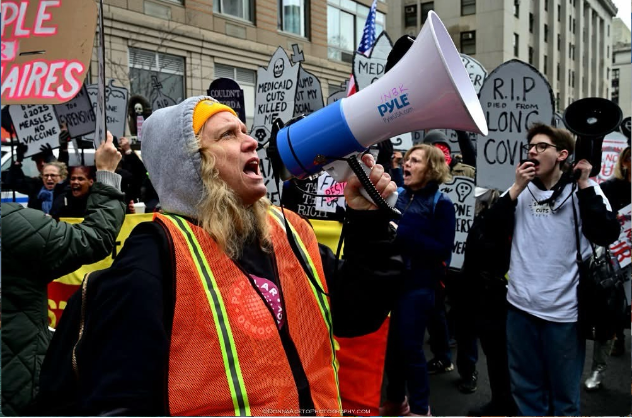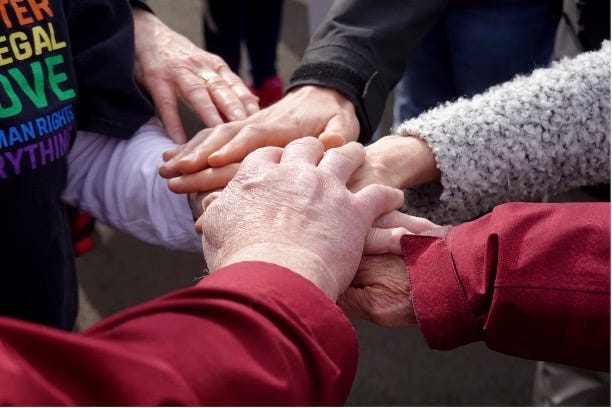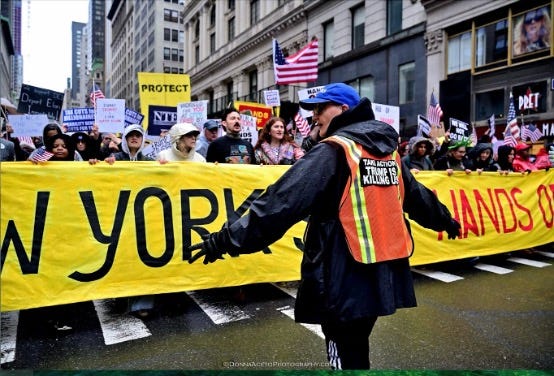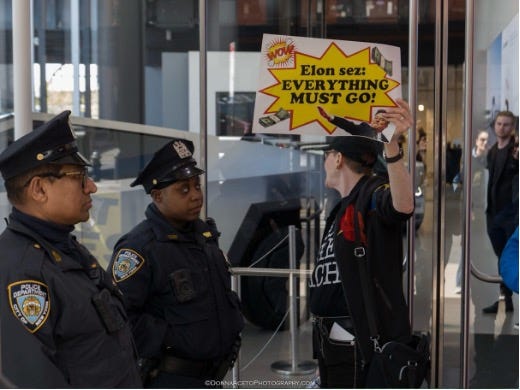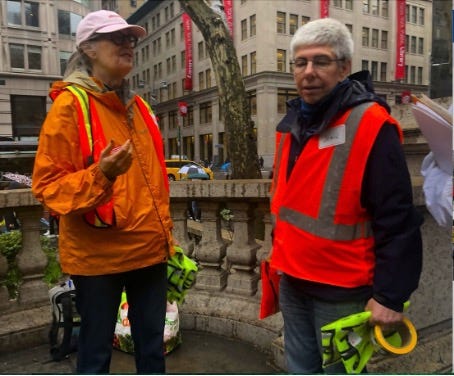Stay Safe While Protesting (New Resource)
Whether protest vet or newbie, take a second to review these reminders of best-practice safety steps while marching today April 19. (& print, carry the poster!).
Staying Safe While Protesting & Organizing:
I’m breaking from usual practice with this post to share the contents below of a new, useful pamphlet on Staying Safe While Protesting — a primer for non-violent resistance —produced by a colleague, Alexis Danzig, of Rise and Resist, and in collaboration with our campaign. We want to make sure everyone is prepared and informed about how to do so, given the possible threat of an Insurrection Act and the rash of warrantless, aggressive ICE arrests we are now seeing.
To date, we have witnessed seasoned activists in every city who know how to organize peaceful events, and plan well to recruit and train marshals, share de-escalation strategies, and think through everything about these events. That’s why the nationwide Hands Off! marches have remained peaceful, joyous, boisterous, furious events, even when they spontaneously grow or shift plans mid-way. They invite millions to channel our opposition and fury at the Trump administration’s policies and actions while keeping participants and observers of these marches safe.
Rise and Resist and ACT UP are two NYC groups who have gained decades of experience keeping activists and those joining demos safe, and offer fee trainings. There are many others, including groups organizing events nationwide. So take a minute to remind yourself or learn what to do before you march today, and consider volunteering to marshal or be trained to do so. Marches also need legal observers especially if civil disobedience is planned. Behind the scenes, focused organizing is a big reason this growing protest movement has quickly grown and is poised to grow bigger today with fresh nationwide protests.
Further below, I’ve shared a graphic (JPEG) for a downloadable poster with a URL and QR link to the pamphlet, and one to a platform that has an updated list of next actions with links to many groups organizing around the country. Please consider sharing, downloading, and printing, the poster to be carried in a march you join, so others can learn to stay safe while marching, and access Next Actions when they are leaving the march. Finally, consider getting marshal, CD, legal monitoring, or other trainings in non-violence organizing as one of your next acts. Rise and Resist is among groups doing free trainings.
Also, please consider helping this safety info get out fast to many more by restocking and sharing the poster with your communities and via other social media platforms you use so we can inform as many people quickly. Thank you for your actions and solidarity. Hands Off Our Government!— ACD
Photo: Donna Aceto
Staying Safe While Protesting & Organizing
Basic Info, Tips & Resources
— Compiled by Alexis Danzig, ACT UP and Rise and Resist
The following information is offered as a guide to better, safer protesting, and organizing. This information does not take the place of legal information.
Know Your Demonstration Rights Under the First Amendment:
"Congress shall make no law respecting an establishment of religion, or prohibiting the free exercise thereof; or abridging the freedom of speech, or of the press; or the right of the people peaceably to assemble, and to petition the Government for a redress of grievances."
-- First Amendment, US Constitution, 1789
The First Amendment gives all people in the United States the right to speak our minds publicly and to gather together to express ourselves nonviolently -- without fear of government harassment. The right to protest publicly, demonstrate, create vigils and moving picket lines, and participate openly in marches is under attack: we defend our rights by using them.
A. What are my rights at a demonstration?
What's legal when protesting:
1. A moving picket on a public sidewalk, with signs and chanting.
2. A sidewalk march, with signs and chanting.
3. Handing out informational leaflets to passersby, without blocking the sidewalk.
Grey Areas: what may/may not be overlooked by police when protesting:
1. A stationary vigil on a sidewalk or in another public place.
2. A bullhorn or a portable battery-operated megaphone.
3. A march in the street, if the protest crowd is sufficiently large.
What a permit is typically required for:
1. A sound amplification device with microphones.
2. A march in the street, or any street closure.
3. A gathering in a public park over a certain number of people.
Photo: Creator: Joni Auden Land | Copyright Credit: OPB
B. ACT UP recommends – 6 general best practices:
1. Organizers: do not ask in advance for a permit:
ACT UP developed out of a protest movement that refused to ask for permission to demonstrate under the first amendment. The first amendment gives us the right to protest publicly. Whenever we ask for permission from the police or parks department, they have an opportunity to demand information about the protest and its organizers; collect money for permits; deny us the right to hold our protest even after a permit has been issued.
2. Train a group of marshals:
ACT UP planned public demonstrations openly, expecting that the police would know about our protests and would show up at our public gatherings. To allow protesters to concentrate on demonstrating, ACT UP developed teams of marshals to provide information to demonstrators, de-escalate difficult interactions, and act as a buffer between protesters and the police. Want a marshal training for your group? Please reach out to Rise and Resist to schedule a training FREE to all pro-democracy groups: nonviolentaction@proton.me
3. Hold rallies sparingly:
In the ACT UP tradition, we advise against creating rallies that require us to stand in place, listening to speakers through sound systems. While speak-outs by the people who are directly affected by injustice is educational, most rallies are static and boring, especially when elected officials are using us as a backdrop. We are experts about our own lives. Elected officials are welcome to join our protests, but we don't need to defer to them.
4. Be prepared to welcome new people into your movement:
If you run a great demonstration, people will want to join. Create information to pass out to protesters so they can learn more about your organization and know how to contact you. Do not use personal email addresses; a group website or organizational email address is useful, if you follow up on emails. This is how we grow movements.
5. Come prepared to protest nonviolently:
Leave weapons and nonprescription medications at home. Dress comfortably for the weather, with shoes that cover your toes -- no sandals or flip flops. Bring current ID with your name, photo, and address. If you're bringing a smart phone, disable any face recognition or fingerprint-access settings, and location settings. You cannot be compelled to type in your password to open your phone. You have the right to take photos and videos of anything in plain view, including buildings, police, and other people. Harassment and stalking are illegal.
6. Protest together:
Consider going with a buddy or a group of pals when you attend demonstrations. If you can't find a person to go with you, let someone who is not at the protest know your schedule, and make a plan to check in at a specific time after the demonstration to make sure that you're safe, not in custody.
For further information see:
ACLU: Know Your Rights
Equal Rights Advocates: Your Legal Rights at a Protest
Photo: Donna Aceto
C. For immigrants and People of Color -- Best practices:
Immigrants and people of color need to take more care while protesting:
While immigrants and people of color have the same first amendment rights as birthright and naturalized citizens, in the current climate our courts are not protecting people with green cards, on visas, or those without documentation. You must balance your right to protest against the risks of participating in public protest. Please check in with your friends who attend protests for their opinions about protesting in your community, and get legal advice from lawyers who are familiar with your status. Consider creating a safety plan in case you're detained or arrested while protesting.
Prepare for being arrested while protesting:
Your safety at a public protest cannot be guaranteed, but you can take precautions:
Memorize the name and number of a lawyer in case you are arrested and held by police.
Go to demonstrations with friends, and have a plan for meeting up afterwards if you get separated.
Let someone who isn't attending the protest know where you are going and have a plan to check in after the protest.
If your contact doesn't hear from you by a pre-arranged time, your contact should take steps to find you and/or to take care of your responsibilities that you may not be able to meet because you are in jail, such as childcare appointments, pet care, and your employment duties.
If you're going to the protest with friends, have a plan to meet up afterwards at a quiet location in case of arrests or police rioting.
Carry COPIES of your immigration documents, not the originals.
A trusted friend should have your permission to access your original immigration documents, in case your lawyer needs to have them scanned and sent.
Photo: Donna Aceto
If questioned by police, you have rights.
You have the right not to answer questions asked by the police.
You have the right to ask the police, "Am I free to leave?" If the answer from the police is yes, you can walk away.
Do not walk away if the answer is no -- if the police say no, you are being detained, and you should not answer police questions.
You have the right to refuse to answer questions, saying to the police, "I choose to remain silent."
You have the right to ask for a lawyer while refusing to answer police questions, "I choose to remain silent, and I want a lawyer.”
If the police pat you down to search you or look inside your backpack say, "I do not consent to being searched."
You should be prepared to give your ID to the police if you are asked for it.
Do not discuss your immigration status with police.
If you make a call for legal assistance, do not discuss your arrest on the phone while in police custody. The police are listening.
Never lie or give false information.
Never sign a document you do not understand. You have the right to ask for a lawyer.
Never resist arrest by running away, struggling, or fighting with police.
If you are arrested, within two days you can expect to come before a judge with a court-appointed criminal defense lawyer to hear what you are being charged with and if you will be released or if bail will be set.
For further information see:
National Immigration Law Center: Know Your Rights: Immigrants' Participation in Protests
Immigration Legal Resource Center, English and Spanish: 10 Things Noncitizen Protesters Need to Know
D. De-escalation Tips:
While we cannot ensure the safety of people during public demonstrations, we can all help make protesting as safe as possible. One way we defuse potential trouble is by taking note of people who show up angry or who become angry while demonstrating: they might be "our" people who are rightfully upset by injustice, or they might be counter-protesters or social media trolls who are there only to disrupt, or they might be drivers who are angry that their path is temporarily blocked.
We all have the right to protest with all our emotions, but protests can become unfocused and may fall apart when one person or a small group of people grabs attention through hostility. Demonstrators can help defuse angry behavior before it escalates further through co-regulation, active listening, and calm communication. Below are a number of tactics that seasoned activists use to help keep calm at public protests.
De-escalation Tactics:
Co-regulation: you can model being calm by being relaxed; take a buddy to approach the yelling person, and introduce yourself by name and ask the person for their name. If you can get the person to listen to you, you will have engaged them in communicating with you in a relatively normal voice -- and they will no longer be yelling disruptively and attracting attention.
Active listening: once you have introduced yourself, ask the person what issues have brought them out to the protest; listen for their answers and keep on asking questions. The longer you keep another person engaged in calm discussion, the more time will pass and the longer your demonstration can continue. This isn't a fun task, but you are doing a real service for the protest.
Calm Communication: if you can get an angry person to converse with you in a normal tone, you may be able to listen and wait them out, sympathetically. Or, you may be able to agree to disagree: if a group of counter demonstrators can agree to the value of freedom of speech, you can suggest that the group move away, down the street, so both your protest and their counter-protest can be heard clearly.
Handling Trolls: trolls are disruptive people who come to demonstrations intending to provoke peaceful protesters into losing their calm. Often trolls will ask provocative questions while videoing demonstrators, with the idea of filming protesters becoming irate, putting the images online, and "owning the libs."
Often, it's sufficient to approach a troll with a buddy; while one person engages the troll in conversation, the other speaks directly to demonstrators, saying, "Please don't engage!" or "Don't take the bait!" or "It's not worth it!" or "Keeping moving, folks, nothing to see here!" If you have time before a protest, you can prepare signs/arrows that can be held up indicating that the person you're speaking with is a troll who should be ignored.
Handling Drivers: when side streets are blocked during a march, drivers may become upset at being delayed. It can be helpful to speak to a driver waiting at an intersection and let them know approximately how much longer they may be held up. Drivers can be helped to reverse down a street to find an alternative route, or where necessary, demonstrators can work together to open an intersection to allow an ambulance to cross the path of the protest.
Photo: Jackie Rudin
E. Training Information for Organizers & Community/Grassroots Groups:
Get trained to participate in nonviolent direct action:In the tri-state area and beyond, Rise and Resist offers two FREE trainings for community groups, 1) marshal trainings (2-hours), and 2) nonviolent civil disobedience trainings (5-hours).
1. Marshal trainings: 2-hours, in-person or by Zoom, FREE. Marshaling is a form of democratic resistance and grassroots community building. A marshal training explains the role/s of marshals at protests (a vigil, a legal picket, or a march) under the first amendment, with an emphasis on de-escalating interactions with the police, counter-protesters, drivers, etc.
2. Nonviolent civil disobedience trainings: 5-hours, in-person, FREE. Civil disobedience is a principled, effective, public method of bringing fierce, peaceful pressure to bear on unjust systems. This 5-hour training -- including a break for lunch -- introduces participants to the philosophy and methods of nonviolence and direct action; how consensus-based decision-making works within affinity groups; arrest and consequences; solidarity as a tool for actions, jail, and court; the role/s of support (legal and jail support); day-of protest tips.
Partnering Organizations:
Partnering organizations are responsible for promoting the trainings to their members, locating a site to hold trainings (houses of worship and libraries are great!), or setting up/managing Zoom, copying the manual for all participants, and providing lunch/snacks as necessary for in-person trainings.
Many local and partnering organizations who are organizing or inviting members to participate in marches will welcome members and newcomers to planning meetings for these resistance marches or actions, whether in-person, hybrid, or online. They generally offer advance training for people interested in being marshals at demonstrations, being trained to participate in civil disobedience, helping to volunteering for a variety of tasks before, during, and after protest actions. For concerns or questions related to safer protesting or organizing at a given event, contact the main coordinator or local partnering organizer of the march or event.
Please reach out to Rise and Resist to schedule a training FREE to all pro-democracy groups: nonviolentaction@proton.me.
Stay safe, stay loud, stay bold.
A digital and pdf version of this pamphlet can be downloaded at www.resistingproject2025.org
Note: The above materials are open source, to. be shared and used by all. Special thanks to organizer Alexis Danzig for producing the content and graphic designer Valerie Wagner for a rapid turnaround, to The Hannahs at 50501-NY for distribution support, to Rise and Resist and ACT UP- NY members for ongoing action prep, marshal and de-escalation training, safety, street smarts — and great chants. The Next Steps poster links to a website with updated permitted and un-permitted resistance events and links to various national groups organizing resistance marches.



